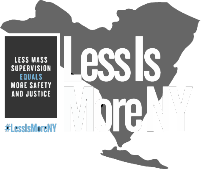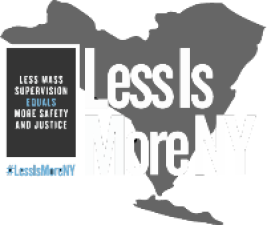By Imani Webb-Smith, Senior Policy Manager at Katal Center for Equity, Health, and Justice
Until very recently, to be on parole supervision in New York State was to be subject to the country’s most deliberately dizzying array of cruel, capricious, racist policies and practices – both codified and de facto,[1] that succeeded only in further ensnaring people in the criminal legal system.
Despite the New York State Community Supervision’s (DOCCS) stated mission and goals to “enhance public safety” through “supportive supervision” to reduce the likelihood of future legal involvement,” years of evidence and data reveal an agency that persistently, overwhelmingly and profoundly fails not only individuals on parole, but families, loved ones and entire communities by every conceivable metric.
Long overdue relief is now at hand. On September 17, 2021, New York’s Governor Kathy Hochul signed the Less is More: Community Supervision Revocation Reform Act into law. [2] That very day, partial implementation of the new law began when Gov. Hochul announced that 191 individuals, held at Rikers on non-criminal technical parole violations, would be released and reunited with their loved ones.[3]
This is a tremendous victory. But challenges remain – while Less is More[4] is now signed into law, its implementation date is March 1, 2022. A provision in the law allows the Governor to implement the full law now. That is what must be done to address the myriad harms of mass incarceration throughout the state at a time of acute crisis.
As we look on in horror at what’s unfolding at Rikers Island jail complex and rightly demand its closure, we must remember that the very same culture of violence, abuse, intimidation, retribution, deplorable and toxic living conditions are features of most of New York City and State’s prisons and jails.
Once fully implemented, #LessIsMoreNY will immediately and drastically reduce the rates of incarcerated people in Rikers and across the state by restricting the use of incarceration for technical violations, incentivizing compliance with parole conditions with the possibility of earned time credits and improving public safety.
Here’s a short summary of how what the Less is More Act will do:
Reducing jail and prison populations in New York and improving public safety through restricting the use of incarceration. and strengthening re-entry.
Today, there are almost 34,000 people on parole in New York State. Approximately 5,000 people – nearly 15% of the state prison population – are incarcerated in prisons and jails throughout the state for non-criminal technical violations of parole. People on parole live with the looming threat of being returned to jail or prison for most non-criminal violations of parole, like being late for curfew, or missing an appointment with one’s parole officer.
It is well established by public safety experts that this practice does not improve public safety, and even serves to undermine it.[5] Incarceration is easily one of the most disruptive, traumatic and destabilizing events an individual, their loved ones and communities will experience, negatively impacting all social determinants of health.[6]
Most people released from prison struggle to obtain stable housing, find and maintain employment, and further their education because of systemic injustices, community disinvestment, and the stigma and discrimination associated with a felony conviction.
Sending people back to jail for non-criminal rule infractions and automatically detaining them for the duration of their parole hearings erases their fragile progress, and once released they must start over again. This leaves many on parole – including Katal members throughout New York — even more vulnerable to homelessness and unemployment, conditions that make it more likely that they will be rearrested for crimes of poverty. This hurts individuals and families, especially those with children who may depend on them for care and financial support, and their broader communities, all with no benefit to public safety.
The Less is More Act eliminates incarceration for many technical violations and severely restricts its use for others, allowing people to safely remain with their families in their communities as they readjust to life outside of prison. It also ends automatic detention based on the mere accusation of a technical parole violation, preventing people from losing their housing, employment, and program enrollment because of an allegation that has not yet been sustained. People on parole who are accused of a new crime are subject to the same penalties from the criminal court system and the parole system as exist under current law, although they will benefit from stronger due process protections under #LessIsMoreNY.
Any serious conversation about decarceration in New York must include the immediate and full implementation of #LessIsMoreNY.
Promoting successful reentry and improve public safety through incentives.
The current parole system utilizes a punitive approach with very few rewards for good behavior. Instead of being incentivized to follow the rules, people on parole are threatened with punishment for breaking them, even when the rule violation results from circumstances beyond their control like appointments scheduled at conflicting times, or a train or bus that is running late. While merit-based discharge mechanisms do exist, they are discretionary and unevenly awarded. This framework discourages people from seeking essential help when they need it, like for a substance abuse disorder, because they are afraid of being returned to prison instead of referred to community-based services.
The Less is More Act shifts parole from a punitive system to an incentive-based system, encouraging people to follow the rules and seek assistance when necessary. It establishes an earned time credits mechanism by which people who adhere to the conditions of their parole can automatically earn early discharge from supervision. Without the threat of reincarceration deterring them, people who want support with substance use, mental health, or a variety of other needs can ask for help and be rewarded for participating in programs that strengthen their reintegration into society. These benefits don’t kick in until full implementation, which should be immediate.
Reducing racial disparities in New York State’s Parole Supervision system.
New York’s current parole system betrays the promise of equal protection under law daily. Racial disparities exist at every stage of the criminal legal system – from police stop to arrest to conviction to parole decisions. New York imprisons more people for technical violations of parole rules than any state in the country.[7] Of people on parole whom New York sent back to prison in 2019, over 85% were reincarcerated for technical parole violations.[8]The racial disparities are stark: across the state, Black people are 5 times more likely and Latinx people are 30% more likely to be re-imprisoned for a technical parole violation than whites. In New York City jails, Black people are incarcerated for technical parole violations at 12 times the rate of whites.[9] New York taxpayers spend more than $680 million annually to reincarcerate people for technical parole violations.[10][i]
A more equitable and just legal system will not create itself. #LessIsMoreNY advances the fight for racial justice by addressing and reforming racist practices in how the state handles technical violations of parole. This is an important step toward a more equitable New York, and is another reason why Less is More must be implemented now.
Reinvesting the Savings from Less is More To Create Stronger and Safer Communities
New York taxpayers spend more than $680 million a year reincarcerating people for technical parole violations.[11] In 2019, New York State spent a staggering $319 million to incarcerate people in state prisons for technical violations.[12] New York City spent $273 million jailing people accused of technical violations, and the remaining 57 counties in the state spent a collective $91 million.[13] By fully implementing the Less Is More Act, the state and its counties will save hundreds of millions of dollars every year that can be reinvested into the communities most harmed by mass incarceration and mass criminalization. Providing critical funding for quality housing, employment and workforce development, education, and services to address substance abuse and mental health needs will create healthy and safe communities.
Conclusion
The need for full and immediate implementation of #LessIsMoreNY is a matter of life and death. The Less Is More Act is a transformative, racial, legal, economic and social justice bill that will benefit all New Yorkers. We implore Governor Hochul and her administration focus its efforts on enacting all provisions of critical justice initiative now to save lives.
[1] United States Department of Justice, Bureau of Justice Statistics. 2020. Probation and Parole in the United States, 2017-2018, Appendix Table 7. Available: https://bjs.ojp.gov/content/pub/pdf/ppus1718.pdf
[2] https://www.governor.ny.gov/news/governor-hochul-announces-major-actions-improve-justice-and-safety-city-jails
[3] Fung, Katharine. Newsweek. September 17, 2021. New York Governor Hochul Orders Release of 191 Inmates Amid Overcrowding Horrors at Rikers. Available: https://www.newsweek.com/new-york-governor-hochul-orders-release-191-inmates-amid-overcrowding-horrors-rikers-1630258
[4] https://www.nysenate.gov/legislation/bills/2021/S1144
[5] Broderick, Barbara, Schiraldi, Vincent, et al. 2020. Statement on the Future of Probation and Parole in the United States. Executives Transforming Probation and Parole (EXiT). Available: https://www.exitprobationparole.org/statement
[6] Jahn, Jackie, Christine Mitchell, and Cheryl Connor. 2020. Incarceration is a Public Health Crisis, During COVID-19 and Beyond. Harvard Medical School Primary Care Review. Available: http://info.primarycare.hms.harvard.edu/review/incarceration-covid-19
[7] United States Department of Justice, Bureau of Justice Statistics. 2020. Probation and Parole in the United States, 2017-2018, Appendix Table 7. Available: https://bjs.ojp.gov/content/pub/pdf/ppus1718.pdf
[8] NY State Assembly, Standing Committee on Correction. 2019. 2019 Annual Report, at 1. Available: https://nyassembly.gov/comm/?id=10&sec=story&story=94293
[9] Kendra Bradner and Vincent Schiraldi. 2020. Racial Inequities in New York Parole Supervision. Available: https://justicelab.columbia.edu/sites/default/files/content/NY%20Parole%20Racial%20Inequities.pdf.
[10] Nims, Tyler, Kendra Bradner, Johnna Margalotti, Zachary Katznelson, and Vincent Schiraldi. 2021. The Enormous Cost of Parole Violations in New York. A More Just NYC and Columbia Justice Lab. Available: https://justicelab.columbia.edu/sites/default/files/content/Cost_Parole_Violations_in_New_York.pdf
[11] Nims, Tyler, Kendra Bradner, Johnna Margalotti, Zachary Katznelson, and Vincent Schiraldi. 2021. The Enormous Cost of Parole Violations in New York. A More Just NYC and Columbia Justice Lab. Available: https://justicelab.columbia.edu/sites/default/files/content/Cost_Parole_Violations_in_New_York.pdf
[12] Id.
[13] Id.

